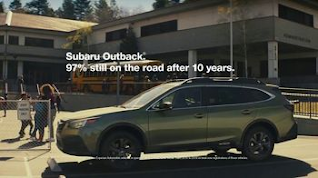This week we focused on the persuasive genre. Persuasive writing intends to convince readers to believe in an idea or opinion. "Persuasion is a part of everyday life" (Tompkins, 2012, p. 252). The persuasive genre is everywhere and is easy to see in our daily lives. We are always being persuaded to buy the newest iPhone or conform to the latest fashion. The persuasive genre group did a great activity with advertisements. We were asked to bring in an advertisement so we could analyze it. I brought in the Subaru print ad below. We were asked to identify the purpose of the advertisement, the targeted audience and which appeal(s) the company was using to persuade you to buy their product. This Subaru Outback Ad used logos, pathos and ethos to appeal a buyer to buy a Subaru.
This ad communicates that a Subaru Outback is a logical investment (logos), a family vehicle that you can take your kids to school in (pathos) and that Subaru is a safe reliable car company (ethos). I really enjoyed completing this activity and I hope to do it with my future students, I think analyzing advertisements is a great way to get students to notice how much media can persuade them.
 Tompkins
(2012) states “persuasion is a part of everyday life” and after our class’s
persuasive writing genre workshop I could not agree more. I learned the ways
writers can persuade people to do or believe something and/or challenge people
to take action. “I Wanna Iguana” by Karen Kaufman Orloff is a great mentor text
to introduce persuasive writing to my future 3-5 students. Orloff uses letter
writing between Alex and his Mom to work through the pros and cons of getting a
pet iguana. Alex really wants one and has to use all 3 appeals to persuade his
Mom to let him get one. “I Wanna Iguana” has humorous undertones and bright
colored illustrations that I know my future class will love! Tompkins
highlights that students should brainstorm a list of examples of persuasion they
notice in their families and school when you first introduce the genre (p. 260).
“I Wanna Iguana” gives students an example of what persuasion might look like
at home. Children definitely know how to pull on heart strings/use the power of
persuasion when they want something special on a Wegmans trip. I think it’s
important that I show students that persuasion is something they already use
and they’re probably really great at it! Tompkins (2012) includes a graphic organizer on page 264 that I plan to use with my future students. It has a place for position, 3 reasons that support the position and then conclusion. I would have my future students pick their "dream pet" after reading I Wanna Iguana in order to write their own "mock" persuasive piece to share with their family. I feel like this will be a fun way for my students to try it out!
Tompkins
(2012) states “persuasion is a part of everyday life” and after our class’s
persuasive writing genre workshop I could not agree more. I learned the ways
writers can persuade people to do or believe something and/or challenge people
to take action. “I Wanna Iguana” by Karen Kaufman Orloff is a great mentor text
to introduce persuasive writing to my future 3-5 students. Orloff uses letter
writing between Alex and his Mom to work through the pros and cons of getting a
pet iguana. Alex really wants one and has to use all 3 appeals to persuade his
Mom to let him get one. “I Wanna Iguana” has humorous undertones and bright
colored illustrations that I know my future class will love! Tompkins
highlights that students should brainstorm a list of examples of persuasion they
notice in their families and school when you first introduce the genre (p. 260).
“I Wanna Iguana” gives students an example of what persuasion might look like
at home. Children definitely know how to pull on heart strings/use the power of
persuasion when they want something special on a Wegmans trip. I think it’s
important that I show students that persuasion is something they already use
and they’re probably really great at it! Tompkins (2012) includes a graphic organizer on page 264 that I plan to use with my future students. It has a place for position, 3 reasons that support the position and then conclusion. I would have my future students pick their "dream pet" after reading I Wanna Iguana in order to write their own "mock" persuasive piece to share with their family. I feel like this will be a fun way for my students to try it out!
References
Orloff, K. K. (2005). I wanna iguana. Scholastic.






Ashley, this entry is a great summary of what took place in class. What would be great is if you tell your readers in these entries, "what next?" In other words, now that you have read Tompkins -- as well as possibly also participating in your peers' Genre Expert workshop on the genre, what do you now see that you better understand about teaching *your* students to read and write in this genre? Where might you make space for similar types of instruction?
ReplyDeleteHi Dr. Jones! I added more to my entry about I Wanna Iguana and how I would use it with my future students in grades 3-5. P.S. I got the job :)
DeleteCongratulations Ashley!
ReplyDelete